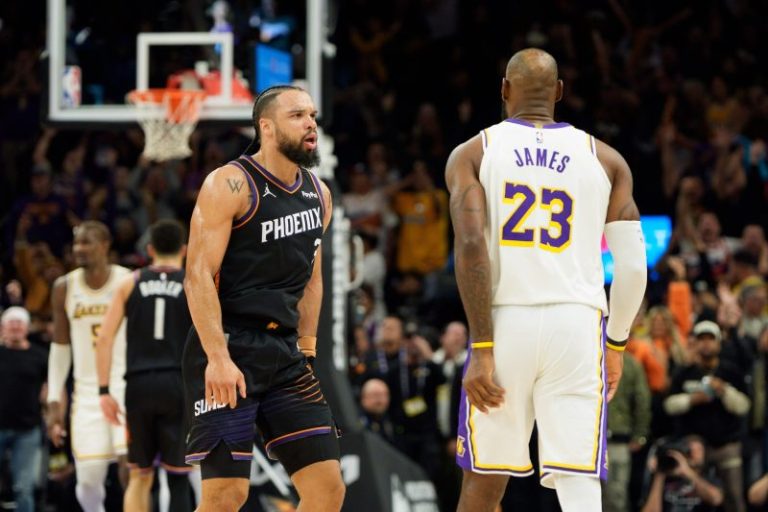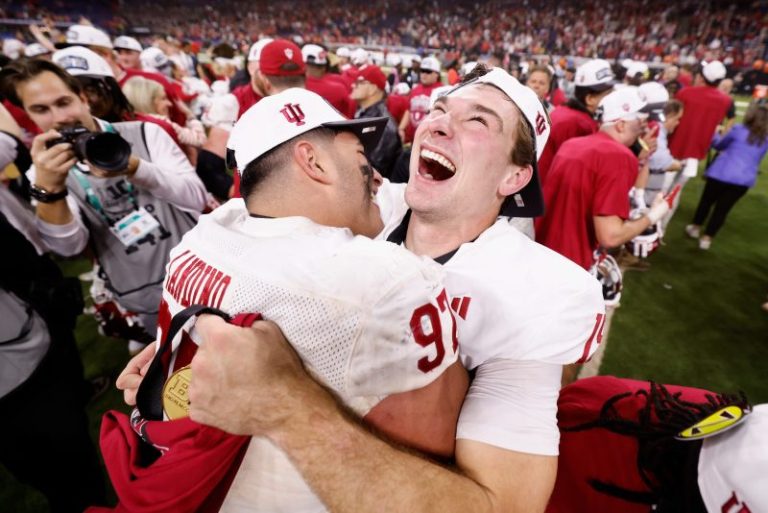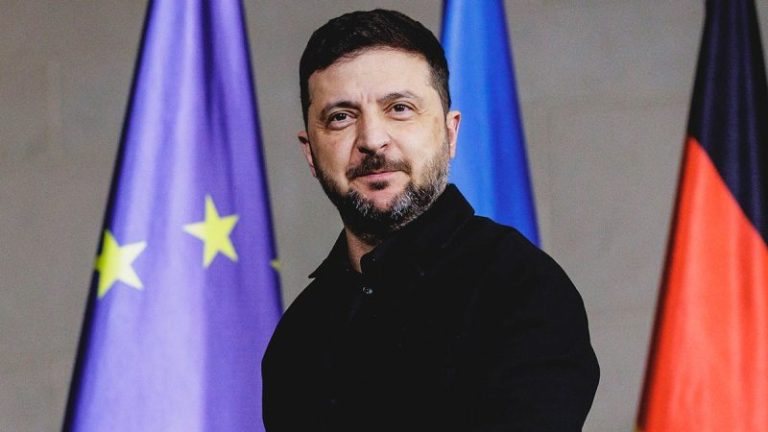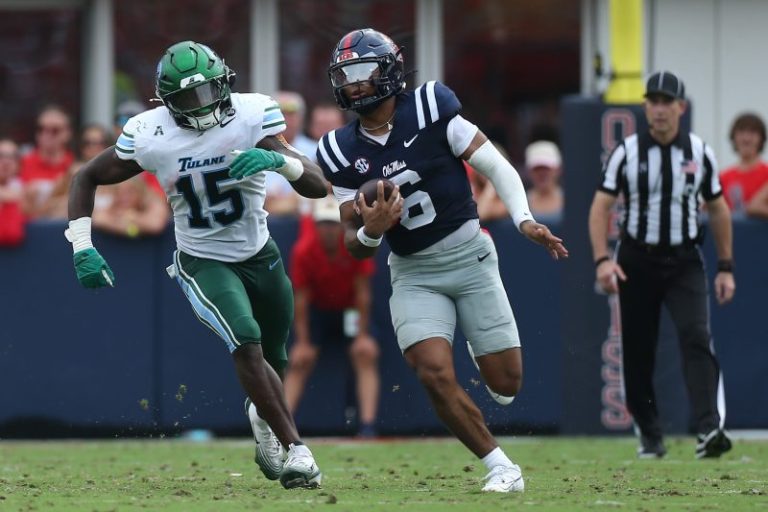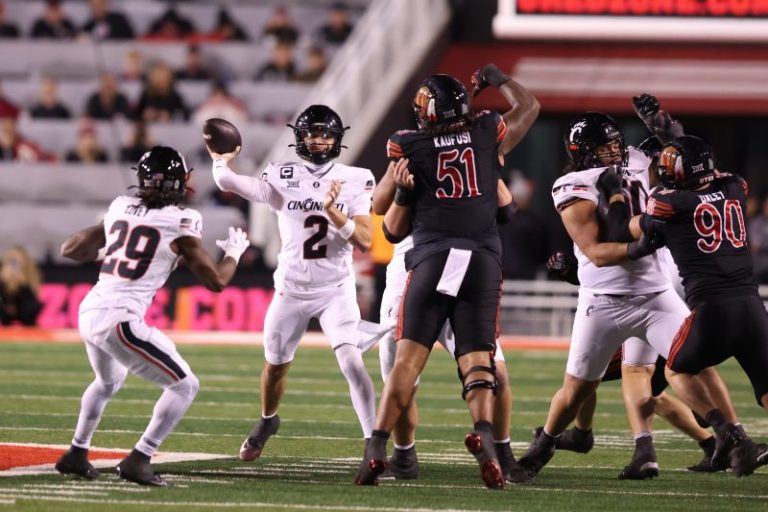As the former winds down one process at the same time the latter gets another going, players are often left to evaluate the actual payoff from participating in the capper to the season. Opt-outs that once sparked controversy have now become commonplace, with those competing in ceremonial contests now routinely bowing out without much fanfare.
The College Football Playoff, however, provides an exception to the rule.
The expanded 12-team field has given NFL teams and fans an additional look at some of the most promising prospects for the upcoming draft. And while a sample size of anywhere from one to three additional matchups shouldn’t override a more robust body of work, the games can be important platforms for players to make a lasting impression against elite competition.
This year’s field features many of the names bound to be called on the first day of the draft. But who’s the best of the best when it comes to players eligible for the 2026 class? With the opening first-round game kicking off Friday, here’s our ranking of the top 25 draft-eligible prospects in the CFP:
Ranking top 2026 NFL draft prospects playing in CFP
1. Arvell Reese, LB/DE, Ohio State
This might have seemed like a potential reach at midseason, when Reese’s meteoric ascension was well underway. By now, the 6-foot-4, 243-pound linebacker can be classified as the top 2026 draft prospect – and the most promising one in the CFP – without raising any suspicions. Of course, he likely would need to be viewed as a full-time pass rusher rather than an off-ball linebacker to justify this ranking. But that switch is no stretch for a wrecking ball who does his best work hunting down ball carriers. The Micah Parsons comparisons are lofty but not without merit.
2. Caleb Downs, S, Ohio State
There’s nothing left to prove at this level for the Jim Thorpe Award winner, who was also a unanimous All-American as a sophomore after transferring from Alabama. Downs is one of the most complete and accomplished players in all of college football, with his sharp instincts and stellar athleticism consistently putting him in the perfect spot to stuff the run or make plays in coverage as the heartbeat of the Buckeyes’ lockdown defense. Positional value considerations might keep him out of the top five on draft day, but the best safety prospect this decade can continue to put on a showcase of what he can bring to the pros.
3. Fernando Mendoza, QB, Indiana
A somewhat muddled early-season outlook for quarterbacks in the 2026 class was resolved by Mendoza’s ascension from Cal transfer to Heisman Trophy winner. The 6-foot-5, 225-pound passer looked at ease throughout the season, comfortably picking apart defenses with poise and precision (71.5% completion rate). Yet he also passed two serious tests when he managed to pull things together late when facing more challenging starts against Penn State and Ohio State in the Big Ten championship game. Arm strength that falls well short of top tier and athleticism that’s merely passable prevent Mendoza from reaching a stratospheric level of pre-draft hype, but he still boasts a strong case to be the No. 1 overall selection.
4. Dante Moore, QB, Oregon
After a rocky freshman season at UCLA in which he completed just 53.5% of his passes, the former five-star recruit needed a reboot. Moore found it at Oregon, where he’s blossomed after sitting behind Dillon Gabriel last season. The 6-foot-3, 206-pounder comfortably attacked every level of the field for the Ducks, displaying an impressive command of the offense and comfort extending plays. Still only 20, the redshirt sophomore has said he’s yet to decide whether to declare for the upcoming draft. While Moore could return to school and position himself to be a contender for the No. 1 selection in 2027, he also might find it hard to pass up the opportunity to be an early selection given the shortage of first-round signal-callers in this class.
5. Rueben Bain Jr., DE, Miami (Fla.)
It was no sure thing that Bain would end up on this list after a letdown of a sophomore season, during which he was hampered by a calf injury. His junior season, however, left no doubt about his capabilities after he carved out his place as college football’s most consistent disruptor. His sack total (4½) doesn’t fully capture his contributions, as he routinely jolted linemen backward and short-circuited plays before they could truly progress. Listed at 6-foot-3 and 275 pounds, he lacks the rangy build that front offices tend to prefer on the edge. That could prove to be a sticking point for some in the pre-draft process, but it’s hard to look past his extensive production, sheer power and knack for winning leverage battles.
6. Carnell Tate, WR, Ohio State
Only at Ohio State’s receiver factory could a former five-star recruit never fully command the spotlight yet end up as an early first-round draft pick. Tate never generated the headlines on a level comparable to fellow Buckeye wideouts Marvin Harrison Jr. and Jeremiah Smith, but he still showed this season how much he could offer any offense as he racked up 838 receiving yards and nine touchdowns despite not being a go-to threat. Between the ease with which he creates separation and his penchant for operating in close quarters – particularly along the sidelines – the 6-foot-3, 195-pounder figures to make himself a trusted target for an NFL quarterback in short order.
7. David Bailey, OLB, Texas Tech
The Stanford transfer was one of the keys to the Red Raiders’ roster reinvention this offseason. Bailey was one of the cornerstones of Texas Tech’s defense, racking up a Power Four-best 13½ sacks. His initial burst off the edge might be unparalleled in the class, yet he can win on more than pure speed alone thanks to an impressive arsenal of moves. His 6-foot-3, 250-pound frame might leave some teams uneasy, but he’s proven to be a surprisingly stout run defender for a player his size.
8. Sonny Styles, LB, Ohio State
The 6-foot-4, 243-pound do-it-all defender has long been a tantalizing prospect thanks to athleticism that suggests he could break the bounds of typical positional work. But what set the former safety apart in 2025 was the comfort level he exhibited operating at linebacker. The son of former NFL linebacker Lorenzo Styles was seldom out of place, as his instincts and recognition skills allowed him to fully unleash his rare speed and knack for dispatching would-be blockers. He could use a little more polish in coverage in order to comfortably handle one-on-one matchups with tight ends, but he has all the tools to do so.
9. Francis Mauigoa, OT, Miami (Fla.)
With Utah’s Spencer Fano and Caleb Lomu not in the playoff, Mauigoa stands above the competition as the premier protector on this stage. The 6-foot-6, 335-pound blocker has made substantial progress – particularly in safeguarding the quarterback – since being installed as a freshman starter at right tackle. While a move inside might alleviate any concerns about his length and range, he has the tools to be an upper-echelon starter at either guard or tackle.
10. Kenyon Sadiq, TE, Oregon
The numbers might fool you when trying to assess Sadiq. Yes, he caught just 40 passes for 490 yards, which makes for a pedestrian 12.3 yards per catch average. But the tight end can be a major seam threat and rack up yards after the catch in addition to being a weapon in the red zone (eight touchdown catches). And at 6-foot-3 and 245 pounds, he might come across to some as merely a supersized receiver. That notion should be summarily dismissed, however, when one sees his impressive body of work as a mauling blocker.
11. CJ Allen, LB, Georgia
From Jalon Walker to Nakobe Dean and Roquan Smith, the Bulldogs are on a tear when it comes to producing highly productive linebackers who don’t tower over opponents. Allen hasn’t received quite the same billing as some of his predecessors, but he should find himself plenty in demand in a league that has a serious shortage of second-level defenders capable of stopping the run and holding up in coverage. While the 6-foot-1, 235-pounder isn’t quite as accomplished in the latter area as he is in the former, he’s a quick study who has all the physical tools to make a significant leap when matching up with tight ends and running backs.
12. Ty Simpson, QB, Alabama
Of all the players considered for this exercise, Simpson was the hardest to peg. Had he continued along his sizzling early trajectory, he would have been a natural candidate for the top five. But his persistent struggles in the last month – with just five touchdowns and four interceptions in his last four games – have raised serious concerns for a player who already presents a difficult profile given his lack of extensive experience. He might be better off returning to school and working on the deep passing that’s lagged so far behind his stellar play in the short and intermediate areas, but it might be tempting to seize the opportunity afforded by a thin quarterback class.
13. KC Concepcion, WR, Texas A&M
Transferring from North Carolina State served Concepcion extremely well. After averaging just 8.7 yards per catch as a sophomore for the Wolfpack, the 5-foot-11, 190-pounder was able to better display his explosiveness in the Aggies’ offense, hauling in 57 receptions for 886 yards and nine touchdowns. His additional work as a returner and all-purpose threat helped him earn the Paul Hornung Award for college football’s most versatile player. Concepcion’s limited wingspan and slight build will put him under more pressure to consistently pull away from defenders, but he looks up to the task.
14. Kayden McDonald, DT, Ohio State
In a class replete with run-stuffing nose tackles, McDonald looks to be the best. The 6-foot-3, 326-pounder has been the driving force for a Buckeyes defensive line that has given up just 84.5 rushing yards per game and 2.8 yards per carry. You won’t find him chasing down quarterbacks regularly, and he still has lapses with his pad level and hand usage that mitigate his disruption. Still, teams might place a premium on his ability to command the line of scrimmage and potentially enable them to play with lighter boxes.
15. A’Mauri Washington, DT, Oregon
After biding his time as a backup for two seasons behind a bevy of talented linemen, Washington announced his presence in a big way in 2025, setting the tone up front for the Ducks’ defense. He’ll be expected to do the same at the next level as a premier run stuffer who can also push the pocket. Washington might still be a tick behind McDonald as a truly transcendent force in stopping rushing attacks, and he similarly doesn’t offer much as a pass rusher at this stage. But the 6-foot-3, 330-pounder could become even more adept at blowing up plays in the backfield given that he has yet to fully harness considerable athleticism for a player his size.
16. Kadyn Proctor, OT, Alabama
It should come as no surprise that every element of the 6-foot-7, 360-pound blocker’s game is outsized. When things are clicking for Proctor, that means devastating blocks in the run game and erasing any threats off the edge. But his lapses also tend to be amplified, as issues with leverage and overextending can lead to big whiffs. He shook off a turbulent start to the season and was named the co-winner of the Southeastern Conference’s Jacobs Blocking Trophy. Still, regardless of how the CFP pans out, he figures to be one of the more polarizing prospects in the first-round mix.
17. Emmanuel Pregnon, G, Oregon
A two-time transfer from Wyoming and USC, Pregnon truly found his stride with the Ducks. Whether it’s paving openings in the run game or warding off interior pressure for his quarterback, the 6-foot-5, 318-pounder has proven to be a well-rounded and reliable fixture at guard, earning first-team USA TODAY Sports All-American honors. Any team in search of a punishing presence along the front could gravitate toward him, potentially in the first two rounds.
18. Cashius Howell, OLB, Texas A&M
A heightened level of competition didn’t stifle the Bowling Green State transfer, who led the SEC with 11½ sacks. Listed at just 6-foot-2 and 248 pounds with questions about his length, however, Howell might still encounter a good number of skeptics as he tries to show he can handle the next transition. He checks almost every other box as a pass rusher, though, as his quickness, fluidity and ability to take a variety of routes to reach the quarterback help compensate for his size.
19. Germie Bernard, WR, Alabama
Bernard could be this year’s Emeka Egbuka lite: a savvy receiver who wins by getting open consistently thanks to crafty route-running rather than pure speed. The 6-foot-1, 209-pounder is more imposing than the former Ohio State standout at the catch point and in the open field, though he’s not as fluid of an athlete as the Tampa Bay Buccaneers rookie. If given the opportunity, he can own the middle of the field and be a major asset to a young quarterback as a short-to-intermediate target and on jump balls.
20. Christen Miller, DT, Georgia
Whether due to lack of opportunity stemming from the Bulldogs’ rigid scheme or his own underdevelopment, Miller never broke out as a pass rusher, recording just four sacks in three years. But his work deconstructing blocks and finding his way to the ball carrier should be enough to earn him a spot in the first two rounds. The 6-foot-4, 310-pounder can be an asset on stunts while he rounds out his game by adding more moves.
21. R Mason Thomas, OLB, Oklahoma
At 6-foot-2 and 249 pounds along with arm length that will fall short of some front offices’ thresholds, he likely will only be a fit for teams running a 3-4 scheme. Still, the ascension of similarly built former Sooner product Nik Bonitto should serve as a reminder that there’s a place in the league for atypically built pass rushers with plenty of explosiveness. Thomas’ pure speed off the edge gives him an excellent starting point, but his comfort getting physical with blockers and redirecting past them makes him more than a one-note threat.
22. Monroe Freeling, OT, Georgia
Freeling hasn’t received the same level of attention as the offensive tackle prospects who have been in the first-round conversation since the spring, but he might not be far behind them. At 6-foot-7 and 315 pounds, he regularly engulfed pass rushers to help Bulldogs quarterback Gunner Stockton settle in this season. His towering frame can work against him, however, as crafty pass rushers at the next level could take advantage of his problems with change of direction. Still a junior with just 17 starts in his career, he could stand to benefit by returning to school. The CFP stage will no doubt be important for his standing after his rough outing last season in a loss to Notre Dame.
23. Matayo Uiagalelei, DE, Oregon
The 6-foot-5, 272-pounder certainly looks the part of a starting NFL defensive end. Uiagalelei moves well for a player his size and has the skill set to finish off plays in the backfield. But he might top out as a complementary piece along the defensive line rather than a focal point.
24. Carter Smith, OT, Indiana
The Hoosiers aren’t lacking for draft-worthy talent, with receivers Elijah Sarratt and Omar Cooper Jr. among those who narrowly missed this list. Still, Smith is only the second Indiana player who made the cut. The Big Ten Offensive Lineman of the Year has been a rock at left tackle, surrendering just five pressures without yielding a sack, according to Pro Football Focus. Suboptimal length and questionable recovery tools might cap the 6-foot-5, 313-pound blocker’s draft stock, but he might still be an attractive option for a team seeking stability up front.
25. Kenyatta Jackson Jr., DE, Ohio State
At 6-foot-6 and 265 pounds, Jackson challenges opposing offensive tackles to match his physicality and tenacity throughout a game – and he often wears them down. He’s not the twitchiest or most fluid threat off the edge, so his pass-rush impact will most likely be felt via hustle and clean-up work rather than quick pressures. But he’s a stout and well-rounded option for any front seeking a rugged presence.
This post appeared first on USA TODAY


